Breathe Bus
BREATHE LUXURY MEDITATION STUDIO ON WHEELS!
319 Hibiscus St #4
West Palm Beach, FL 33401

BREATHE LUXURY MEDITATION STUDIO ON WHEELS!
319 Hibiscus St #4
West Palm Beach, FL 33401
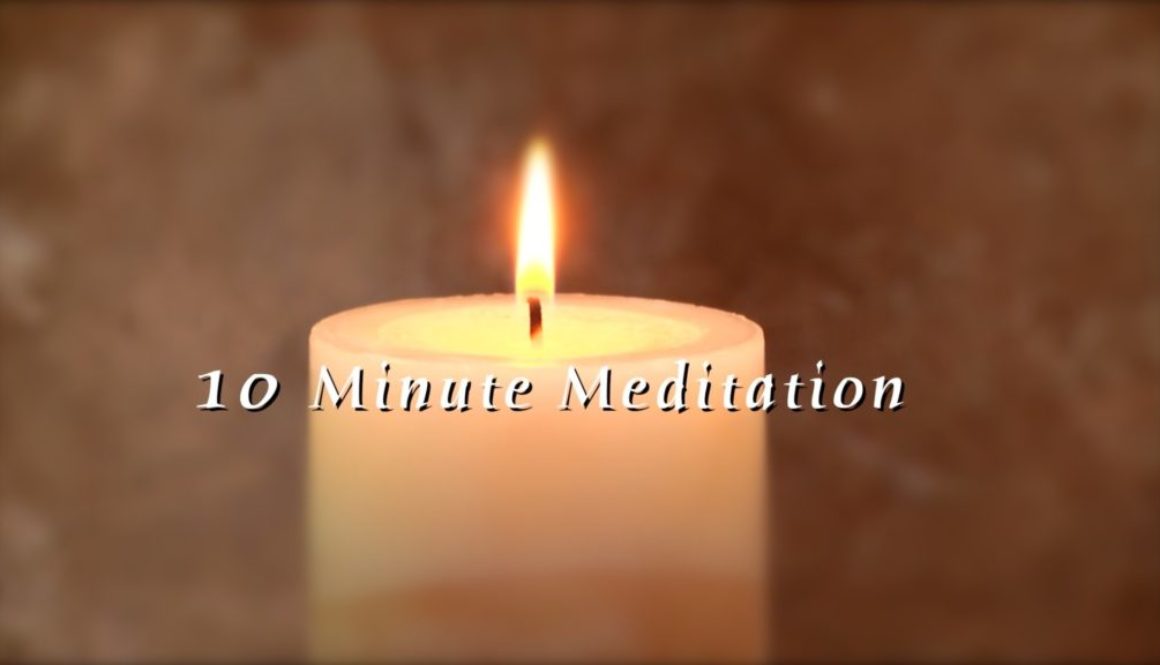



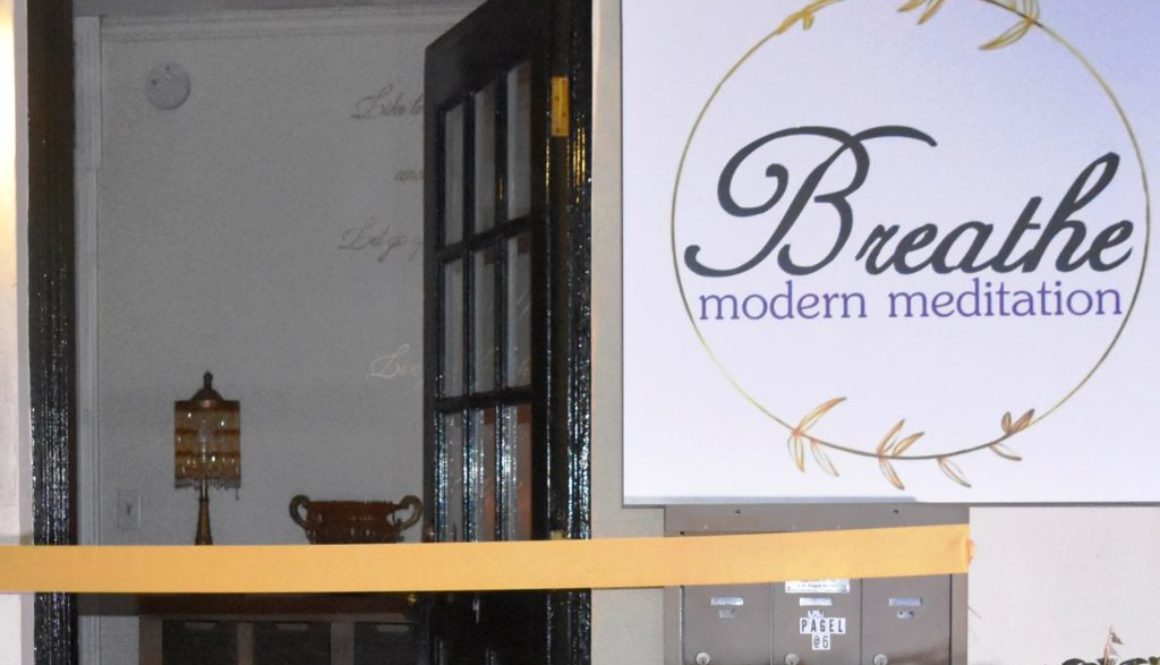
Breathe Modern Meditation Ribbon Cutting
The Ribbon has been cut! Breathe Modern Meditation is officially open. Breathe Freely and schedule your first class free by following the instructions here: http://breathemodernmeditation.com/breathefreely/ Please share and Invite friends!The only secular mainstream guided meditation studio in WPB for people with busy minds and busy lives!
Posted by Shift Happens on Friday, November 10, 2017
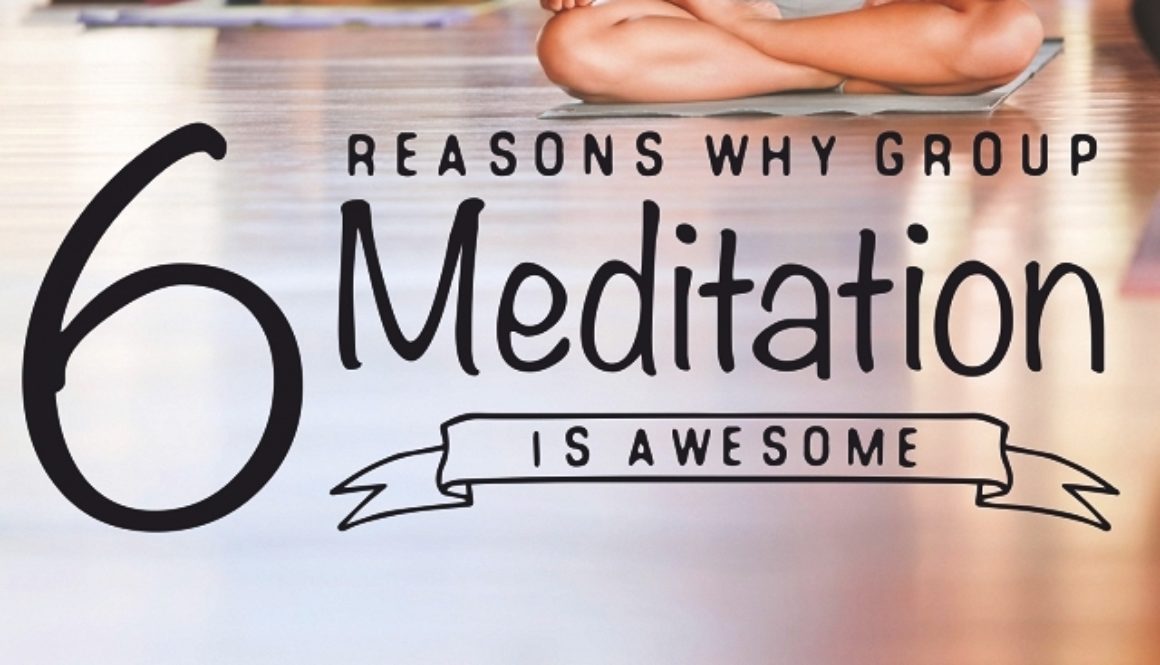
We spend a lot of time alone without realizing it. Sure, it might not always seem like we’re alone when we’re communicating on Twitter, sharing images on Instagram or Pinterest, or liking friends’ status updates on Facebook, but scrolling is, nonetheless, a solitary pastime. It keeps us in one place, and time flies by. No wonder it seems so difficult to fit in that yoga class or add 15 minutes of meditation into a daily schedule. Socializing has been redefined by our technological lives and communication has never been so easy, yet maybe it’s too easy and making us a little too comfortable with our solitude.
Nothing can compare to a physical face-to-face connection. The feel of a genuine laugh or the satisfaction of sharing ideas in person is far better than reading a text and misunderstanding the intended meaning of the typed message because it didn’t include a smiley face emoji. Go for a real smile on a real face more often.
Nothing can compare to a physical face-to-face connection.
And when it comes to yoga practice? Yoga literally means “union” of mind and body. We may go to class to practice asana in community, but what about meditation? Even if it’s just once a week, joining a group of like-minded souls for meditation has tons of benefits for the whole person, mind, body and spirit. The convincing link between the mind and body is well established, and health and wellness advocates in the medical profession are prescribing meditation for stress-related problems. Sure, you could go it alone at home, but group meditation has some unique benefits.
Here are six excellent reasons to meditate with others:
Just like music, meditation can be enjoyed on its own or with others who dance to the same beat. You can feel a real connection with others by tapping into the same silence and source of peace at the same time. In fact, we can literally meet people on the same wavelength: recorded EEG results show that brainwaves synchronize while meditating.
It’s easy to find excuses not to meditate at home. Just like meeting friends at the gym for group fitness class can motivate you to work out, finding a meditation group can provide the necessary encouragement for developing a consistent practice.
Meditation groups often include practitioners of varying levels. If you’re new to meditation, you might find that other members of your group can help clear up any confusion you may have over different types of meditation, help you find answers addressing difficulties with practice, and provide feedback regarding experiences that arise during the meditation process.
According to the book “Bowling Alone: The Collapse and Revival of American Community” by Robert D. Putnam, joining a group can cut your risk of dying in the next year in half! Loneliness is now proven to be bad for our health. An environment of acceptance and belonging are perfect conditions under which social animals like us can thrive.
A group can better support an individual’s inward journey. It’s inspiring and motivating to connect with others who share our intentions for world peace. It is easier to apply Gandhi’s suggestion to “be the change you wish to see in the world” when you are part of a collective crowd. According to Andrew Kelley at The Boston Buddha, it is also a good way to “collectively unify and add strength to our intentions” with a common group goal even if the goal is just to be more relaxed and less reactive.
Believe it or not, there are studies that prove the existence of a ripple effect of peace in the surrounding environment when a group meditates together. According to the unified field superstring theory in physics, waves of vibration flow from everything in the universe affecting the collective consciousness. Groups have the power to enliven that field. Cellular biologist Bruce Lipton states in his book “Biology of Belief” that our consciousness can change the physical world around us by altering the field. An interesting experiment tested a theory called “The Maharishi Effect” in Merseyside, England. A number that exceeded one percent of the population meditated together every day from 1988 to 1991, and the crime rate dropped so much that Merseyside went from third highest to the lowest-ranked city in England during the time of the analysis. Meanwhile, the control town of non-meditators held a steady crime rate. Meditation was the only factor in the study that could account for the change, as the scientists calculated that police practices, local economics, and demographics remained the same throughout the study.
Believe it or not, there are studies that prove the existence of a ripple effect of peace in the surrounding environment when a group meditates together.
As Margaret Mead once said, “Never doubt that a small group of people can change the world. Indeed it is the only thing that ever has.”
Meditation classes and groups can often be found in clean, friendly, secular environments like yoga studios or at specific meditation organizations like Unplug in Los Angeles or Stil Studio in Boston, with many more opening up in between the two coastlines. In New York City there’s The Path, which is a pop-up meditation group that changes locations every week both to keep things fresh and to prove that we don’t need perfect conditions to meditate. Or, if you can’t find a local group, you could start your own using the “Meet Up” app. Rather than allowing technology to become a distraction, you can make it work in your favor! You can use an app to find or start a group. Perhaps each week someone could bring a favorite, guided meditation to share with the group—from an app, yoga website, or YouTube video, for example. This keeps things fresh and the learning curve goes up.
Meditating in a group is a fun and healthy way to socialize and learn a new skill that is good for our mind, body, and spirit. Take meditation group leader and author of “Happy Yoga” Steve Ross’s advice: “Aim for the center, take a deep breath, and dive in!”
https://yogainternational.com/article/view/6-reasons-why-group-meditation-is-awesome

Meditation is a word that has come to be used loosely and inaccurately in the modern world. That is why there is so much confusion about how to practice it. Some people use the word meditate when they mean thinking or contemplating; others use it to refer to daydreaming or fantasizing. However, meditation (dhyana) is not any of these.
Meditation is a precise technique for resting the mind and attaining a state of consciousness that is totally different from the normal waking state. It is the means for fathoming all the levels of ourselves and finally experiencing the center of consciousness within. Meditation is not a part of any religion; it is a science, which means that the process of meditation follows a particular order, has definite principles, and produces results that can be verified.
In meditation, the mind is clear, relaxed, and inwardly focused. When you meditate, you are fully awake and alert, but your mind is not focused on the external world or on the events taking place around you. Meditation requires an inner state that is still and one-pointed so that the mind becomes silent. When the mind is silent and no longer distracts you, meditation deepens.
From childhood onward, we have been educated only to examine and verify things in the external world. No one has taught us how to look within, to find within, and to verify within. Therefore, we remain strangers to ourselves, while trying to get to know others. This lack of self-understanding is one of the main reasons our relationships don’t seem to work, and why confusion and disappointment so often prevail in our life.
Very little of the mind is cultivated by our formal educational system. The part of the mind that dreams and sleeps—the vast realm of the unconscious which is the reservoir of all our experiences—remains unknown and undisciplined; it is not subject to any control. It is true that the whole of the body is in the mind, but the whole of the mind is not in the body. Except for the practice of meditation, there is no method to truly develop control over the totality of the mind.
The goal of meditation is to go beyond the mind and experience our essential nature—which is described as peace, happiness, and bliss. But as anyone who has tried to meditate knows, the mind itself is the biggest obstacle standing between ourselves and this awareness. The mind is undisciplined and unruly, and it resists any attempts to discipline it or to guide it on a particular path. The mind has a mind of its own. That is why many people sit for meditation and experience only fantasies, daydreams, or hallucinations. They never attain the stillness that distinguishes the genuine experience of deep meditation.
We are taught how to move and behave in the outer world, but we are never taught how to be still and examine what is within ourselves. When we learn to do this through meditation, we attain the highest of all joys that can ever be experienced by a human being. All the other joys in the world are momentary, but the joy of meditation is immense and everlasting. This is not an exaggeration; it is a truth supported by the long line of sages, both those who renounced the world and attained truth, and those who continued living in the world yet remained unaffected by it.
Meditation is a practical means for calming yourself, for letting go of your biases and seeing what is, openly and clearly. It is a way of training the mind so that you are not distracted and caught up in its endless churning. Meditation teaches you to systematically explore your inner dimensions. It is a system of commitment, not commandment. You are committing to yourself, to your path, and to the goal of knowing yourself. But at the same time, learning to be calm and still should not become a ceremony or religious ritual; it is a universal requirement of the human body.
Learning how to be still is the method of meditation. The process of cultivating stillness begins with the body. In the yoga tradition, you are guided by a competent teacher to keep your head, neck, and trunk straight while sitting in a meditative posture (asana). When you have learned to be comfortable in this posture, you should form a regular habit of practicing in the same posture at the same time and at the same place every day.
Find a simple, uncluttered, quiet place where you will not be disturbed. Sit on the floor with a cushion under you or in a firm chair, with your back straight and your eyes closed. Then bring your awareness slowly down through your body, allowing all of the muscles to relax except those that are supporting your head, neck, and back. Take your time and enjoy the process of letting go of the tension in your body. Meditation is the art and science of letting go, and this letting go begins with the body and then progresses to thoughts.
Once the body is relaxed and at peace, bring your awareness to your breath. Notice which part of your lungs are being exercised as you breathe. If you are breathing primarily with your chest you will not be able to relax. Let your breathing come primarily through the movement of the diaphragm. Continue to observe your breath without trying to control it. At first the breath may be irregular, but gradually it will become smooth and even, without pauses and jerks.
Meditation is a process of giving your full attention to whatever object you have chosen. In this case you are choosing to be aware of the breath. Allow yourself to experience your breathing in an open and accepting way. Do not judge or attempt to control or change it. Open yourself so fully that eventually there is no distinction between you and the breathing. In this process many thoughts will arise in your mind: “Am I doing this right? When will this be over? Perhaps I should have closed the window. I forgot to make an important call. My neck hurts.” Hundreds of thoughts may come before you and each thought will call forth some further response: a judgment, an action, an interest in pursuing the thought further, an attempt to get rid of the thought.
At this point, if you simply remain aware of this process instead of reacting to the thought, you will become aware of how restless your mind is. It tosses and turns like you do on a night when you cannot fall asleep. But that is only a problem when you identify with the mind and react to the various thoughts it throws at you. If you do, you will be caught in a never-ending whirlwind of restless activity. But if you simply attend to those thoughts when they arise, without reacting, or if you react and attend to the reaction, then they cannot really disturb you. Remember—it is not the thoughts that disturb you, but your reaction to them.
When you meditate, you give yourself an inner vacation.
Meditation is very simple. It is simply attending. You can begin by attending to your breath, and then if a thought comes, attend to it, notice it, be open to it—and it will pass. Then you can come back to the breath. Your normal response is to react to all your thoughts, and this keeps you ever busy in a sea of confusion. Meditation teaches you to attend to what is taking place within without reacting, and this makes all the difference. It brings you freedom from the mind and its meandering. And in this freedom you begin to experience who you are, distinct from your mental turmoil. You experience inner joy and contentment, you experience relief and inner relaxation, and you find a respite from the tumult of your life. You have given yourself an inner vacation.
This inner vacation is not a retreat from the world but the foundation for finding inner peace. You must also learn to apply the principle of attending in your worldly activities, so that you can apply yourself in the world more effectively. Through practicing meditation you can learn to be open to what comes before you in your daily life and give it your full attention.
Ordinarily, you react to the experiences that come before you in much the same way that you react to your thoughts. If someone says something negative to you, you become angry or depressed. If you lose something, you become emotionally upset. Your mood depends on what comes before you, and, as a result, your life is like a roller coaster ride. You react before you have fully experienced what you are reacting to. You immediately interpret what you see or hear according to your expectation, fears, prejudices, or resistances. You short-circuit the experience, and thus limit yourself to one or two conditioned responses instead of responding to a situation openly and creatively.
But if you apply the principle of meditation to experiences that come before you, you can fully attend to what is taking place. You can attend to your initial reaction without reacting to your reaction: “Oh, look how threatened I feel by that.” Let yourself be open to experiencing your reaction and it will move through you and allow other spontaneous responses to also come forward, so that you can select the one that is most helpful in that particular situation.
In this way meditation is very therapeutic. It not only leads to inner balance and stability, it also exposes your inner complexes, your immaturities, your unproductive reflexes and habits.
In this way meditation is very therapeutic. It not only leads to inner balance and stability, it also exposes your inner complexes, your immaturities, your unproductive reflexes and habits. Instead of living in these complexes and habits and acting them out, they are brought to your awareness and you can give them your full attention. Only then will they clear.
Have patience and do your practice systematically. Every action has a reaction. It is not possible for you to meditate and not receive benefits. You may not notice those benefits now, but slowly and gradually you are storing the samskaras (impressions) in the unconscious mind that will help you later. If you sow a seed today, you don’t reap the fruit tomorrow, but eventually you will. It takes time to see results; be gentle with yourself.
Meditation means gently fathoming all the levels of your being, one level after another. Be honest with yourself. Don’t care what others say about their experiences—keep your mind focused on your goal. It is your own mind that does not allow you to meditate. To work with your mind, you’ll have to be patient; you’ll have to work with yourself gradually.
Some of the most important benefits of meditation make themselves known gradually over time and are not dramatic or easily observed.
At first you may see progress in terms of physical relaxation and emotional calmness. Later you may notice other, more subtle changes. Some of the most important benefits of meditation make themselves known gradually over time and are not dramatic or easily observed. Persist in your practice and you will find that meditation is a means of freeing yourself from the worries that gnaw at you. Then you are free to experience the joy of being fully present, here and now.
https://yogainternational.com/article/view/the-real-meaning-of-meditation
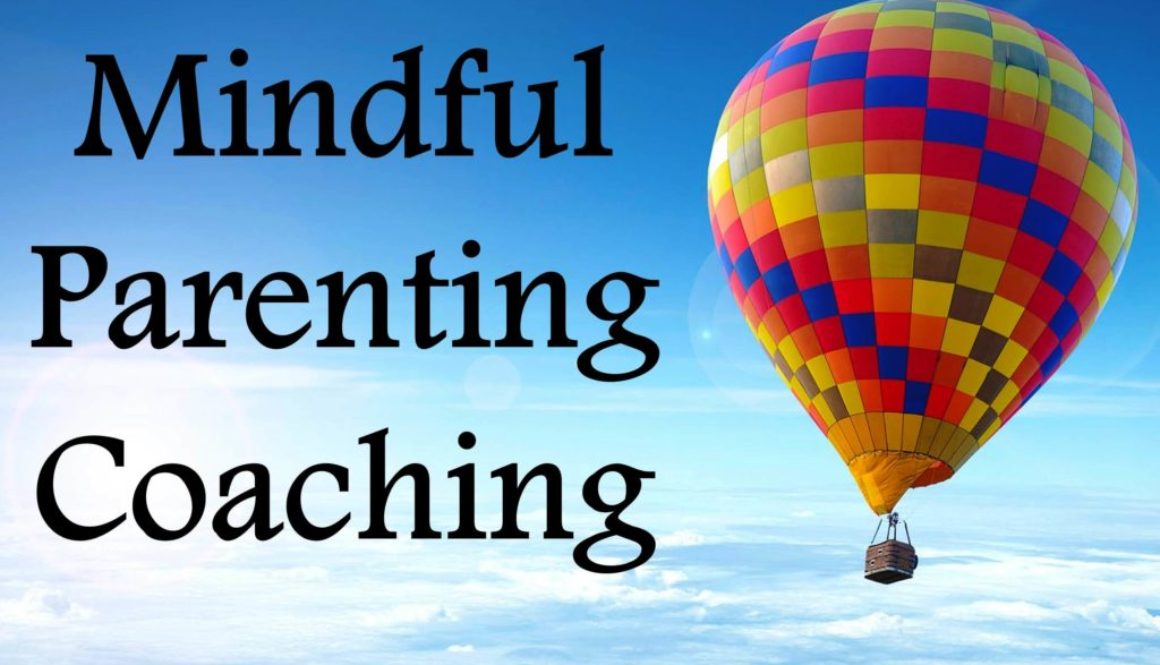
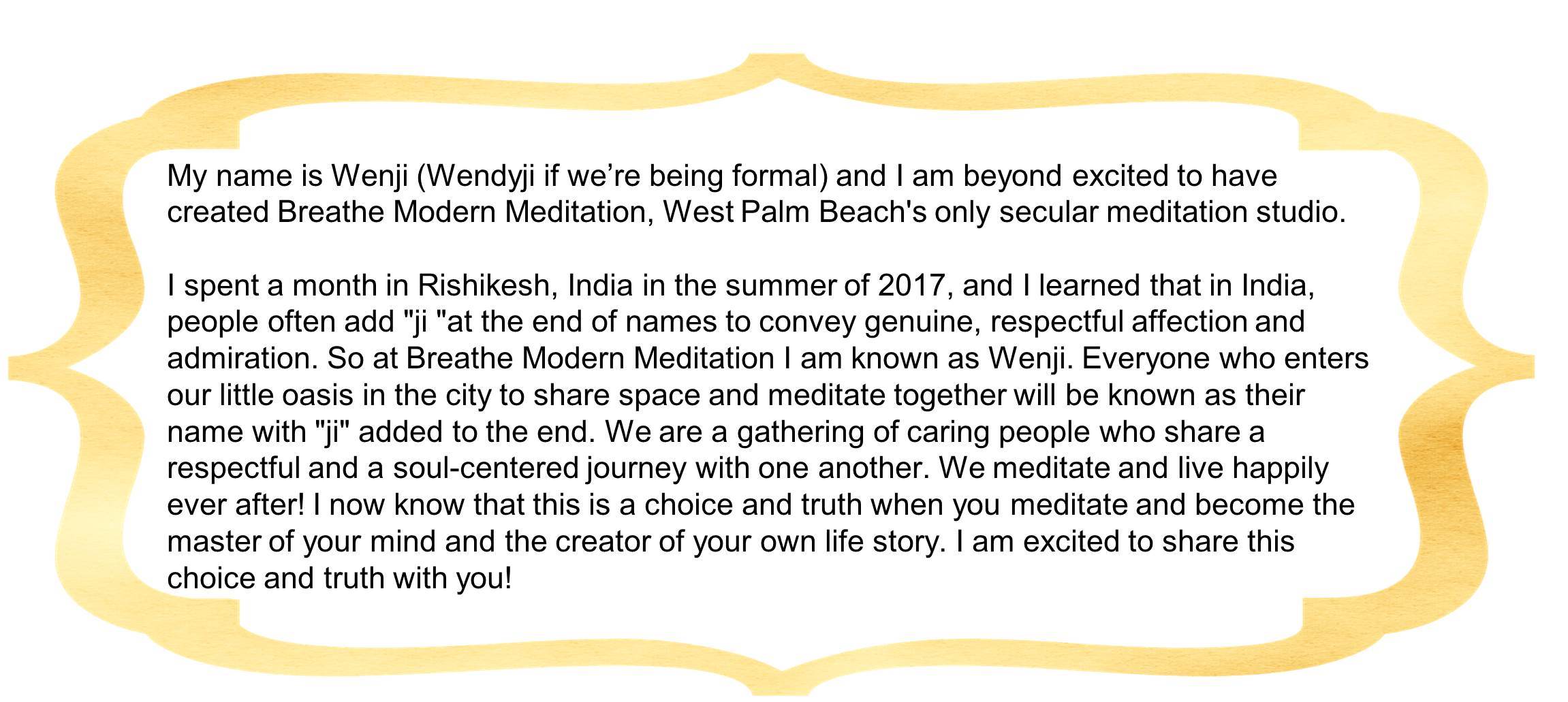
If you would like to review my professional biography and list of achievements Click Here.
If you want to know how I became a soul centered human being, then read on.
My Meditative Miracle:


Wendy Soderman, Shift Happens Mindfulness Business Consultant.
Bio: Click Here.
“If you have not met, spoke to, heard from or heard about the most amazing Wendy Soderman you need to! Today!!! She will change your life and most definitely your outlook on it!!! One of the best speakers our Wellington Chamber Florida has ever had the privilege to hear from !!!”
Michela Perillo, Executive Director of Wellington Chamber of Commerce
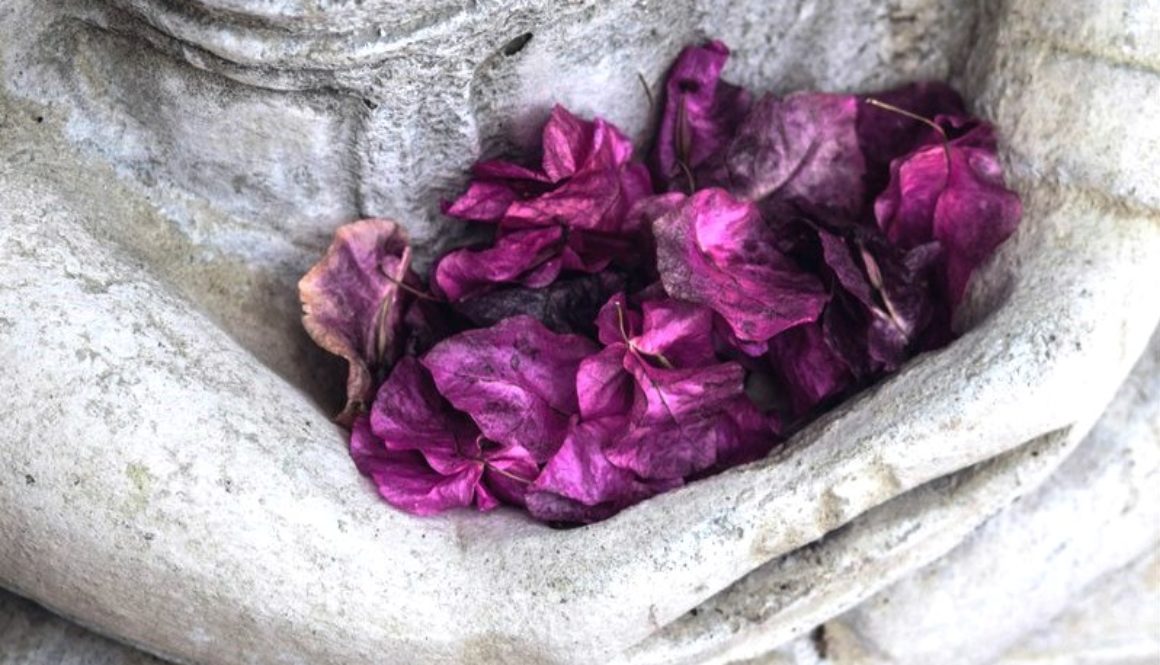
Book your own private meditation session (1 to 2 hour) at your convenience with founder Wenji.
Meditating in a private one-on-one setting is great for all levels of meditators, beginners or seasoned. An individual’s meditation practice is a personal journey.
Breathe Modern Meditation offers private sessions to help initiate or deepen one’s practice. We look forward to providing personalized instruction with an opportunity to ask questions, get answers, and receive customized feedback to meet individual needs and lifestyles.
Sessions are customized in length and are held with Founder and Lead Meditation, teacher Wenji.